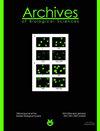Overexpression of BNIP3 in rat intervertebral disk cells triggers autophagy and apoptosis
IF 0.8
4区 生物学
Q4 BIOLOGY
引用次数: 0
Abstract
Excessive apoptosis of intervertebral disk cells and intervertebral disk degeneration (IDD) is the prime cause of low back pain. B-cell lymphoma 2 (Bcl-2) and adenovirus E1B 19 kDa interacting protein 3 (BNIP3), a member of the Bcl-2 family, are involved in cell autophagy and apoptosis. The roles and mechanisms of BNIP3 in intervertebral disk cell autophagy and apoptosis are unclear. In this study, primary rat intervertebral disk cells were prepared to study the effect of BNIP3 overexpression on their autophagy and apoptosis. The cell counting kit (CCK)-8 assay showed that BNIP3 overexpression decreased cell viability. Real-time PCR and Western blotting showed that BNIP3 overexpression significantly upregulated the expression of autophagy-related proteins and pro-apoptotic proteins, including hypoxia-inducible factor-1?, apoptotic protease activating factor 1, caspase 3 and cleaved caspase 3, microtubule-associated proteins 1A/1B light chain 3 (LC3) and Beclin-1 while downregulating the expression of anti-apoptotic protein Bcl-2. Cell staining detection of autophagy and apoptosis showed that BNIP3 overexpression significantly increased the autophagy and apoptosis of rat intervertebral disk cells. BNIP3 RNA interference revealed that the effects of BNIP3 overexpression can be reversed. These findings suggested that BNIP3 enhanced the autophagy and apoptosis in the rat intervertebral disk cells in vitro, which might promote IDD development.BNIP3在大鼠椎间盘细胞中过表达可引发自噬和凋亡
椎间盘细胞过度凋亡和椎间盘退变(IDD)是腰痛的主要原因。b细胞淋巴瘤2 (Bcl-2)和腺病毒E1B 19kda相互作用蛋白3 (BNIP3)是Bcl-2家族的成员,参与细胞自噬和凋亡。BNIP3在椎间盘细胞自噬和凋亡中的作用和机制尚不清楚。本实验制备大鼠椎间盘原代细胞,研究BNIP3过表达对其自噬和凋亡的影响。细胞计数试剂盒(CCK)-8检测显示,BNIP3过表达降低了细胞活力。Real-time PCR和Western blotting结果显示,BNIP3过表达显著上调自噬相关蛋白和促凋亡蛋白的表达,包括缺氧诱导因子-1?凋亡蛋白酶激活因子1、caspase 3和cleaved caspase 3、微管相关蛋白1A/1B轻链3 (LC3)和Beclin-1表达下调,抗凋亡蛋白Bcl-2表达下调。细胞自噬和凋亡染色检测显示,BNIP3过表达显著增加大鼠椎间盘细胞的自噬和凋亡。BNIP3 RNA干扰表明,BNIP3过表达的影响是可以逆转的。上述结果提示,BNIP3可增强体外培养大鼠椎间盘细胞的自噬和凋亡,可能促进IDD的发生。
本文章由计算机程序翻译,如有差异,请以英文原文为准。
求助全文
约1分钟内获得全文
求助全文
来源期刊
CiteScore
1.40
自引率
0.00%
发文量
25
审稿时长
3-8 weeks
期刊介绍:
The Archives of Biological Sciences is a multidisciplinary journal that covers original research in a wide range of subjects in life science, including biology, ecology, human biology and biomedical research.
The Archives of Biological Sciences features articles in genetics, botany and zoology (including higher and lower terrestrial and aquatic plants and animals, prokaryote biology, algology, mycology, entomology, etc.); biological systematics; evolution; biochemistry, molecular and cell biology, including all aspects of normal cell functioning, from embryonic to differentiated tissues and in different pathological states; physiology, including chronobiology, thermal biology, cryobiology; radiobiology; neurobiology; immunology, including human immunology; human biology, including the biological basis of specific human pathologies and disease management.

 求助内容:
求助内容: 应助结果提醒方式:
应助结果提醒方式:


